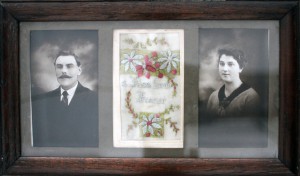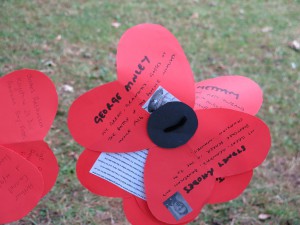October 13, 2014, by Matt Davies
‘Lest we forget’: Life Lines’ World War I digitisation workshop in DHC.

‘A Kiss from France’ William and Dorothy House with a postcard sent from the front by William’s brother Harry who was killed in action 7th June 1917. Thanks to Caroline Reffin (Grandaughter of William) for use of the image and information -more information here.
Photo Matt Davies.
Life Lines is a public engagement initiative by the University of Nottingham’s Lakeside Arts Centre and the Manuscripts and Special Collections (MSC) Department. It began in April 2014, and is funded by Innovations in Museum Displays whose mantra is ‘participation over interaction’.
The aim of the Life Lines project is to engage Lakeside visitors by inviting them to respond directly to the exhibitions in the Weston Gallery using their own family archives. The recent series of workshops run by the Life Lines team of Ruth Lewis-Jones (Lakeside Arts Centre) and Charlotte Pratley (Culture Syndicates) was related to the Gallery’s ‘All Quiet in the Weston Gallery’ exhibition, which commemorated the centenary of the First World War.
Charlotte invited me to host Workshop 5 of the series, Digitising and Sharing your Documents here in the DHC and I gladly took her up on the offer! The session was held on Friday 18th July and we began with a tour of the Centre and its equipment, and then we discussed some of the benefits and pitfalls of digitising and preserving artefacts. Notes and research links from this and the other workshops can be found here.
Members of the group brought along some of their own personal/family items from WWI; these included a wedding photograph from the period which had seen a little wear and tear -including a few splashes of paint- a framed postcard with photographs of the sender and recipient (see image above), an amazing and extensive collection of embroidered postcards, and a set of sepia photographs of men in uniform with handwritten information on the reverse.
Following the talks, we had a go at digitally capturing and optimising some of the artefacts using the DHC’s scanners and the copy stand and camera –or Annie as we call it! (all of our workstations have Arts and Humanities themed names, I’ll leave you to work out who Annie might be named after… think cameras). The software we used was primarily Photoshop –to crop, straighten and clean images up where necessary or appropriate (further discussion below) and Adobe Acrobat 9PRO. The latter is particularly useful if you have an item with multiple pages, or if both sides are relevant and need to be kept together in one file, for instance the aforementioned postcards and photographs with inscriptions on the back.
For most documents and photographs a flatbed scanner is the obvious choice and so it proved during the workshop. The DHC has an assortment of scanners ranging in size from A0, that’s approximately 85x120cm (ideal for maps, plans and posters) down to A4. Many have transparency units (TPUs) so will scan negatives of all shapes and sizes; we also have a 35mm slide scanner and have just acquired a book scanner which is proving very popular with teaching staff. If the object is 3D, like the framed photographs pictured, then that is where Annie comes in.
There are always a few technical problems- that is the nature of working with tech (I always add PCs to the famous mantra ‘never work with children or animals’) Most problems can be resolved with a little head scratching and experimentation and we do enjoy a challenge! For instance, I am aware that given a little more time –and camera expertise – the reflections that you see on the image above could be avoided, perhaps by changing lighting, lenses, angles, shutter speed…. or what about removing the items from the picture frame? That might seem the obvious answer but this is where the difficult decisions begin. Is it appropriate to remove the pictures from the frame? Perhaps they were lovingly framed by a relative many years ago? Maybe they are old and delicate and will not stand handling? In the case of the wedding photograph, Photoshop can be used to remove those paint spots and indeed Charlotte was able to do just that, but perhaps those paint spots are part of the history of the object? Maybe they dripped onto the photograph whilst the happy couple was decorating their first post-war home together… or a nursery..? To be quite honest, in this case the owner was pleased that we were able to rectify this relatively recent decorating mishap, but one can imagine!
It is very easy to tinker with contrast and colour levels in Photoshop and make the image sharper, remove crease lines, fading (ironic when so many photography apps will add all of these things!) or even –heaven forbid -add colour to black and white images! All of these things need to be carefully considered and discussed before valuable time – time always means money – is spent on them. Indeed there are many things which require consideration before embarking on a digitization project; storage and organization of the digital assets, metadata (the information that tells us what the asset is and helps us to search it), workflows, copyright and so on. Unfortunately there is not space here to explore these things; the notes from the workshop make many suggestions and I always recommend JISC Digital Media’s website to anyone thinking about digitisation projects.

Inscribed paper poppy in Highfield Park, Life Lines final event, 5th August, 2014.
Photo Charlotte Pratley.
When the series had concluded, the Life Lines group kindly invited me and the other hosts to its final event which turned out to be a lovely way to conclude a series of workshops which had focussed on, what is, after all, an emotive subject. The names of some of the people in the photos whose stories were pieced together or remembered during the workshops were written by the participants on paper poppies (see below) and displayed in Highfield’s Park near the Lakeside Arts Centre. We held a minute’s silence and then raised a glass of Christmas Truce beer (provided by Nottingham’s Castle Rock brewery and brewed to commemorate WWI) in memory of all who fought. Samples of the sort of cakes and jams that were sent to the front during the conflict had been made by members of the group and I enjoyed Parkin cake for the very first time!
The Life Line participants, and indeed anyone with similar artefacts, images and stories to share have been encouraged to do so on the Life Lines Interactive Station. It makes fascinating and often moving reading. Perhaps this helps to remind us that the digitisation process -and perhaps more broadly –the digital revolution with all of its opportunities is always just a means to a more human end. This might be reading a book on a kindle, listening to music on an iPod, watching films on hand held devices, searching digital family history archives, or indeed as in this case lest we forget!
No comments yet, fill out a comment to be the first

Leave a Reply